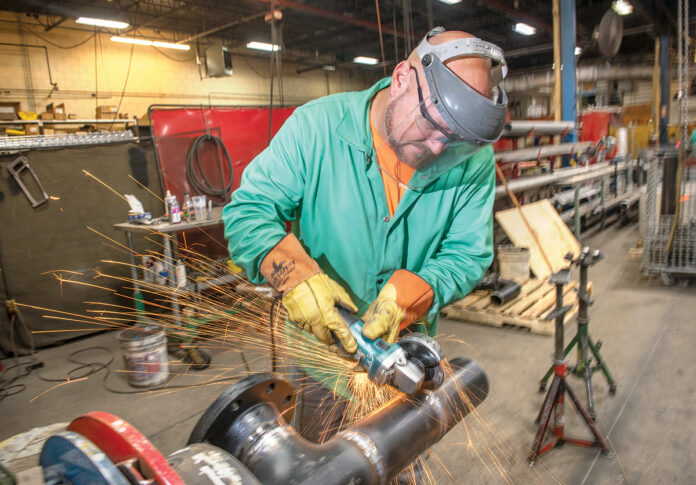
Still wanted: Quality-control personnel, estimators, project managers, welders and many others for construction companies in Rhode Island.
There are simply not enough people to go around.
“They are all unique,” said Michael Sabitoni, business manager of the Rhode Island Laborers District Council and president of the Rhode Island Building Trades, of construction roles. “We are talking about 17 different laborers, electricians, carpenters, cement masons … We are very specialized in what we represent.”
COMING UP SHORT
Although the Northeast is a bit better than the national average – 75% of construction firms here are having difficulty hiring as opposed to 80% in the United States – Associated General Contractors of America says there is certainly room for improvement.
Brian Turmail, AGC vice president of public affairs and strategic initiatives, calls the results of the August survey frustrating.
“I think the most surprising finding is the duration of these workforce shortages,” despite training efforts, he said. “We see states [such as] Rhode Island launch programs – such as efforts to educate high schoolers on the opportunities in construction. … But the workforce shortages aren’t going away.”
According to the AGC, 35% of construction companies expect similar difficulty in hiring and 36% expect it to get even tougher in the coming year.
And it isn’t just the entry-level type of roles such as pipe layers, installers or electricians that have openings. Educators and building companies say management-level positions go unfilled as well, especially project manager, engineer and estimator slots.
The labor-shortage picture is no brighter in residential building, said John Marcantonio, Rhode Island Builders Association executive director.
“The sheer number coming in and those retiring out is a big problem,” he said, citing the average age of a retiring tradesperson in their late 50s. He noted that the transfer of residential construction knowledge, say from father to son in a family business, is a fraction of what it used to be.

FOUNDATION SET
This past summer, Gov. Gina M. Raimondo announced a collaborative, private-public program that brings several organizations together with a goal of creating more skilled workers to fill construction roles. The R.I. Department of Labor and Training, AGC of Rhode Island, Construction Industries of Rhode Island and Rhode Island Building and Construction Trades are part of the effort.
The plan, unnamed at this writing, is in the formative stages. Guided by employer demands, Real Jobs Rhode Island will work to get new commercial-construction workers trained and hired.
The easiest way to describe Real Jobs RI is that it’s an administrative platform that allows people to collaborate, said Scott Jensen, director of the DLT. As of July, it had connected 3,757 people with new-hire training, 3,132 of whom are employed, according to its website, across 16 industry sectors.
“So, the task becomes how are we going to get Rhode Island to take advantage of opportunities in commercial construction? How are we going to create a coordinated effort?” he said.
Alyssa Alvarado, Real Jobs RI program director, said that the commercial-construction workforce initiative focus will be strategic to avoiding repetition and crossover efforts in curriculum, location and more.
To that end, a full analysis is needed of what is already there.
“First priority is to get a demand assessment. How short are we, in what areas? Where do we ramp up [career technical education] programs in the state to better tailor them to that demand?” Alvarado said.
From there, the correct curriculum needs to be developed with the right training equipment, such as what students or incumbent workers will be using in the field, she said.
Involvement of local companies in curriculum creation – to ensure materials address their needs so that they can use students after training – is key. “They need to have a job at the end of it,” said Jensen.
Marcantonio lauds Real Jobs RI as a unique model helping residential construction dig its way back after the recession as well. “It was our Great Depression, and it’s been a rebuilding process,” he said.
Marcantonio praises the grant programs that include industry as part of the solution.
“Most of the time, the government’s reaction to a problem is, “How do we fix it?’ ” with mixed results, he said, crediting Real Jobs RI with knowing the importance of involving all sides in solving a problem.
And despite those AGC survey results showing the lingering worker shortage in the broader Northeast, Sabitoni of the laborers union, which teams up with agencies such as the R.I. Department of Transportation to offer apprenticeships, sees some progress in employee recruitment.
CULTURAL SHIFT
Industry players in Rhode Island acknowledge the pervasive stereotype of construction as an industry that only offers manual work. Christina Gibson, human resources manager of Arden Building Cos. of Pawtucket, knows that even in 2019, outdated misconceptions exist.
With locations in three states, Arden has about 275 Rhode Island employees.
“People don’t really realize the opportunity that exists in construction management,” Gibson said, “and that it involves the use of technology,” building information modeling programs, for example.
“You can be in the field, be a project manager, do office work, computer tasks, finances … construction can lend itself to different backgrounds.”
Days of posting ads when positions come up are over, as are relying on strict qualification criteria. The company does more consistent outreach to build relationships with potential new team members with a focus on the long term.
Though some upper-level positions demand certain requirements, Gibson said, “We’re recognizing that people from different backgrounds add value and drive an organization forward,” with hiring managers more open to diversity of experience.
In addition to exploring some candidates with varied backgrounds, soft skills are getting more play in Arden’s proactive prospect considerations as well.
Sometimes known as “people skills,” it’s an area that’s also the focus of employment-readiness training for Opportunities Industrialization Center of Rhode Island.
BEYOND HARD-SKILLS
The nonprofit OIC specializes in teaching soft skills to prospective employees in not just construction but other industries as well. It is a crucial piece of the employment puzzle.
The bridge to employment needs to be complete to ensure retention, said Ron D’Orio, director of operations with OIC Rhode Island. One soft skill needed is being on time for work. Experience and training may be in place but don’t always make a candidate a long-term employee.
“Trouble with day care and transportation could derail someone in a job,” he said, ultimately making a hire of little value.
Whichever way the learning happens, construction is an evolving industry in need of regular reassessment to ensure its workers are well prepared, said Michael Emmer, an assistant professor of construction management at Roger Williams University.
“Sustainability – the use of renewable resources – [is] continually changing. As society changes its view and science becomes more available, so will the types of buildings we build and their impact. It’s an ongoing process and not static by any means,” he said.
The concept of construction as dirty work should be getting further and further in our collective rear-view mirrors, says Turmail, of AGC. He notes that more and more firms are bringing onboard robotics, exoskeletons that assist in mobility and endurance, and drones.
“Construction workers today are as likely to be wielding an iPad as they are a hammer,” he said. The field needs to be viewed as a promising career that can be attained without college debt.
The Unspeakable Problem
Rhode Island is no exception to the deadly narcotics crisis raging across the nation.
Opioid-overdose deaths have hit the sector hard. R.I. Department of Health data from July 2016 to June 2018 showed that those in natural resources, construction and maintenance occupations constitute nearly a quarter of all fatal opioid overdoses in Rhode Island.
“I would suspect aging of our industry plays a role,” said John Marcantonio, Rhode Island Builders Association executive director. “If you’re not able to perform work, you’re not providing. The potential was there for these folks to work through pain.”
Leaders have emerged in combatting the problem.
This spring, for example, Providence-based Gilbane Building Co. personnel were trained by the R.I. Disaster Medical Assistance Team in recognizing signs of an opioid overdose, and how to administer Naloxone, which reverses the effects. In support of that effort, the company is stocking its job sites with Naloxone Rescue Kits.
Both Marcantonio and R.I. Department of Labor and Training Director Scott Jensen agree that the construction industry is accepting of those in need of second chances, perhaps more than others.
“If you’re a team member who has faced the problem and come every day and do good work? Positive builds on positive,” said Jensen.
(Corrects to Gary Evans in photo caption.)
Susan Shalhoub is a PBN contributing writer.












